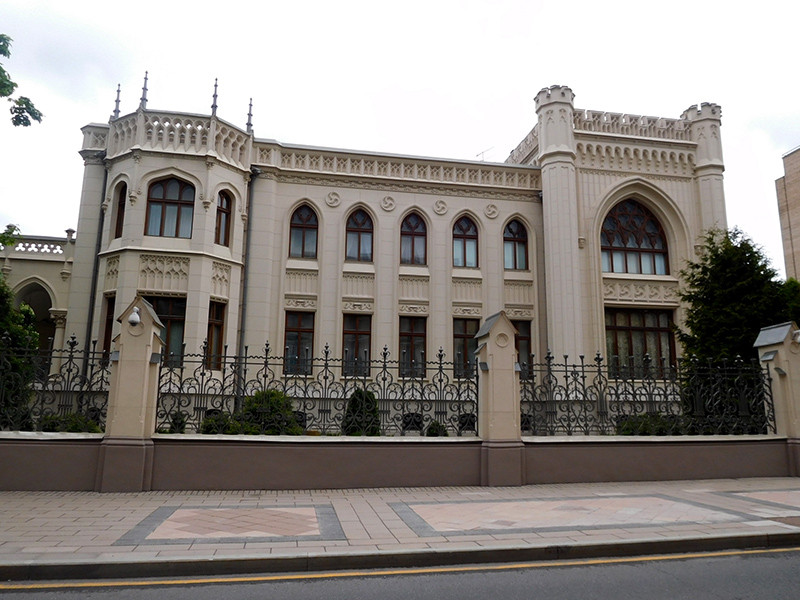[ad_1]
Photos from inside the prison where opposition hero Alexei Navalny is being held show the grubby reality behind Russia-EU diplomacy.
A Russian court sentenced him to three and a half year’s prison on bogus charges on Tuesday (2 February).
He is being held at the Matrosskaya Tishina prison in Moscow until his appeal is heard, when he is likely to be transferred to a more remote penal colony.
There are no reports that Navalny has been mistreated while in detention.
And foreign ministers from Germany, Lithuania, and Sweden, among other EU states, redoubled calls for his release on Tuesday, ahead of a high-profile trip to Moscow by EU foreign relations chief Josep Borrell on Thursday.
Borrell is to meet Russian foreign minister Sergei Lavrov, most likely at his Gothic mansion on 17 Spiridonovka Street, a stone’s throw from the iconic Kremlin palace complex.
The red-carpet treatment will mark the first time the EU’s top diplomat has visited Russia in four years.
Its high value for both sides is clear from the fact most trips have been cancelled due to the pandemic.
There will be no concrete decisions, or “deliverables” in diplomatic terms.
Instead, Borrell and Lavrov are to discuss “strategic” issues – grand international affairs, such as nuclear proliferation and the Syria and Ukraine conflicts.
Borrell has also requested to meet Navalny and other dissidents during his three-day visit.
The Kremlin’s spokesman, Dmitry Peskov, said there was no reason for such a meeting on Tuesday.
“They [Borrell] and [Navalny] are not relatives, they don’t know each other, they are nobody [to each other],” Peskov said.
Peskov added that it would be “stupid” if the EU “linked” Russia relations to Navalny’s case, for instance, by imposing targeted sanctions on Russian officials.
The Russian foreign ministry’s spokeswoman, Maria Zakharova, also complained that EU diplomats had attended Navalny’s court hearing.
“It’s not a normal practice … when diplomats, the more so, collectively, are present when cases of not their citizens are tried it is rather a political move,” Zakharova said on Tuesday, after some 20 European and US diplomats turned up.

Peskov did not categorically rule out a Borrell-Navalny meeting.
But if Borrell does go and see the Russian anti-corruption campaigner in Matrosskaya Tishina, he and European media would see a face of modern Russia that is a far cry from the pomp and circumstance of Lavrov’s Gothic palazzo, not to mention the $1bn mansion that Navalny recently accused Russian president Vladimir Putin of building himself on the Black Sea coast.
The photos of the prison published by EUobserver go back to 2009, when a former inmate, anti-corruption campaigner Sergei Magnitsky, was killed there.
Some show just how impoverished Russian prison health services appear, compared, not least, to the German hospital where Navalny was recently treated after Russian spies poisoned him.
Others show grubby washing facilities and general living conditions.
There have been some renovations in Matrosskaya Tishina in the past 10 years, according to Ivan Cherkasov, a Russian émigré living in London who used to work with Magnitsky.
And there are no reports that Navalny has been mistreated while he was there.

But some of the photos from the Matrosskaya Tishina prison in Moscow also showed that inhuman treatment was normal at the Russian facility.
Some of the cells – called “stakans”, a Russian word meaning “cylinders” – are so small that prisoners can just about sit down inside.
“In many cases, they’re used as torture chambers where a person is locked in for a substantial period of time without being able to move, causing psychological and physical suffering,” Ivan Cherkasov, a Russian émigré living in London told EUobserver.
“Many of these cylinders, though not the ones shown in these pics, are so tiny that prisoners can’t sit down. All they can do is stand,” he said.
“You can imagine what a human being feels like after a few hours of standing upright, bricked up in the wall,” he added.
The prison held “all kinds of people – businessmen under investigation, political activists, protesters and other detainees”, Cherkasov noted.
“It’s notorious for extracting false confessions using torture,” he said.

Meanwhile, back in the diplomatic salons, Borrell will probably have a stark choice to make, one EU diplomat predicted.
Borrell will either “play along” with Russia’s line on the need to mend EU relations, in which case he might be “rewarded” with the positive media coverage that a Navalny prison-visit would give him, the EU source said.
Or Lavrov might make a laughing stock of the EU VIP, for instance, by belittling Borrell at a press briefing, as well as denying him a Navalny photo-opportunity, if Borrell is too critical of the Russian regime.
“They’ll probably keep him [Borrell] guessing on the Navalny visit until the last minute [of his trip],” the EU diplomat predicted.
Some EU states, especially former communist ones in central Europe, were unhappy that Borrell was reaching out to Russia in this way.
“The Russians are using Navalny to try to split EU solidarity even further,” the EU diplomat said.
And if that was true, then the dirty faucets and corridors of Matrosskaya Tishina aside, Lavrov’s use of Navalny as a hostage also showed the grubby reality behind Russia’s diplomatic facade.

[ad_2]
Source link
